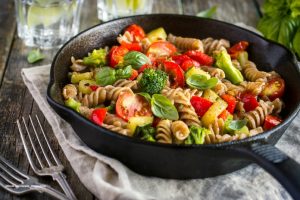The United States Department of Agriculture (USDA) recently conducted an analysis about the cost of health foods. Many people say that convenience foods such as fast food meals, and junk foods such as chips and candy, are cheaper than nutrient dense foods. The study is titled Are Healthy Foods Really More Expensive? It Depends on How You Measure the Price.
 When measured on a price per calorie basis, that’s true. French fries or potato chips are cheaper, per calorie, than strawberries or celery. But when measured by weight, nutritive value, and portion size, the healthy foods are less expensive than junk food.
When measured on a price per calorie basis, that’s true. French fries or potato chips are cheaper, per calorie, than strawberries or celery. But when measured by weight, nutritive value, and portion size, the healthy foods are less expensive than junk food.
It’s a sad fact that most American diets do not meet USDA and FDA recommendations. Healthy foods are defined as foods that “contain only moderate amounts of saturated fats, added sugars, and sodium”, as well as food that contains at least half the portion size used to measure nutrients in that particular food.
If your goal is to gain weight, vegetables and fruits are an expensive way to accomplish that goal. But if your goal is to eat the most nutrient dense foods, grains, dairy, and fruit are less expensive than junk food. Nutritional economy and caloric economy are two different things. Eating to fill yourself up without regard to nutrients will cost more in the end in the form of increased health care costs and compromised health.
For instance, the average serving size of potato chips is cheaper than the average serving size of a baked potato, but the baked potato will give you more nutrients per dollar spent. And you’ll feel more satisfied longer after eating the baked potato.
The authors estimated the cost for 4,439 foods by price per calorie, price per edible gram, and price per average portion consumed. The study found that vegetable and protein groups are the most expensive, followed by fruit. Grains and dairy are the least expensive food groups. Vegetables are expensive because of the large amount recommended in a healthy diet.
The USDA’s Food Plan recommends that our diets consist of 22 to 26% vegetables, 15 to 16% fruit, and 21 to 22% protein. The chart “Rankings by Price Metric For Selected Foods” on page 25 in the study found that these foods are nutritious and relatively inexpensive:
- Pinto beans
- Whole potatoes
- Peanut butter
- Corn tortillas
- Lettuce
- Oatmeal
- Orange juice
- Cow’s milk
- Pasta
The study concludes:
“When making food choices, consumers may need to consider the entire cost of their diets. Cheap food that provides few nutrients may actually be “expensive” for the consumer from a nutritional economy perspective, whereas a food with a higher retail price that provides large amounts of nutrients may actually be quite cheap. Consumers should also consider the total daily cost – which is likely the one metric that will have the most relevance to consumers trying to control their food budgets.”
For more information about a healthy diet, see the USDA’s Choose My Plate web site.




